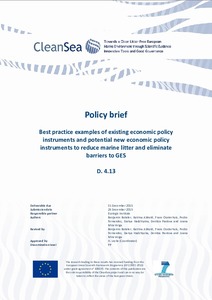Policy brief: Best practice examples of existing economic policy instruments and potential new economic policy instruments to reduce marine litter and eliminate barriers to GES. D. 4.13.

View/
Average rating
votes
Date
2015Author
Boteler, Benjamin
Abhold, Katrina
Oosterhuis, Frans
Fernandez, Pedro
Hadzhiyska, Dariya
Pavlova, Denitza
Veiga, Joana Mira
Status
PublishedPages
13pp.
Metadata
Show full item recordAbstract
Marine litter is a complex problem and recognised as a major and growing environmental
concern (UNEP, 2009). It threatens marine ecosystems and biodiversity (e.g. through ingestion
or entanglement by marine species) and ultimately risks human well-
being by damaging
socioeconomic activities (e.g. losses to fishing or clean up costs) and posing health risks (e.g.
ingestion of plastics through the food chain) (EEA, 2015). Marine litter originates from div
erse
and various, sources both land and sea
-based, and the types of items which end up in the
world’s seas and oceans are both varying and numerous (UNEP, 2009). Those often identified
include plastic caps and lids, bottles, plastic bags, hygiene products,
food containers, fishing
nets, and cigarette butts (Interwies et al. 2013). These items can be found in great quantities
on the ocean floor, in the water column, floating at sea, .....
Resource URL
www.cleansea -project.euPublisher
Ecologic Institute for CleanSea ProjectBerlin, Germany
Document Language
enSustainable Development Goals (SDG)
14.1Best Practice Type
Best PracticeGuide
Citation
Boteler, B.; Abhold, K.; Oosterhuis, F.; Fernandez, P.; Hadzhiyska, D; Pavlova, D. and Veiga . J,M, (2015) Policy brief: Best practice examples of existing economic policy instruments and potential new economic policy instruments to reduce marine litter and eliminate barriers to GES. D. 4.13. Berlin, Germany, Ecologic Institute for CleanSea Project, 13pp. DOI: http://dx.doi.org/10.25607/OBP-198Collections
 Repository of community practices in Ocean Research, Applications and Data/Information Management
Repository of community practices in Ocean Research, Applications and Data/Information Management